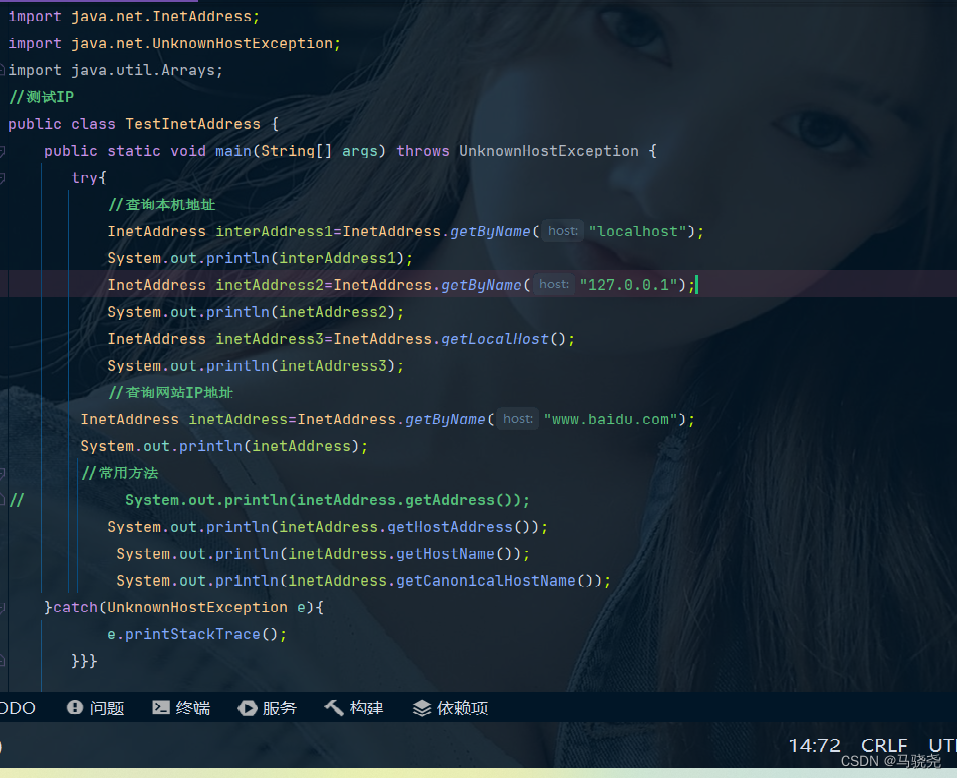IP:用来定位一台计算机。
ip地址的分类:
IP地址分类:
- ipv4:4个字节组成,每个字节0~255。
- ipv6:8个无符号整数组成。
公网(互联网),私网(局域网):
- ABCD地址
- 192.168.xx.xx,专门给组织内部使用
下面是对IP创建和常用方法:

端口:计算机上的一个程序的进程。
端口的分类:
公有端口(0~1023):
HTTP:80; HTTPS:443; FTP:21; Telent:23。
程序注册端口(1024~4915):
Tomcat:8080; MySQL:3306; Oracle:1521。
动态,私有端口(49152~65535)。
如下是端口的创建和常用方法:
public class TestInetSocketAddress {
public static void main(String[] args) {
InetSocketAddress socketAddress=new InetSocketAddress("127.0.0.1",8080);
InetSocketAddress socketAddress1=new InetSocketAddress("localhost",8080);
System.out.println(socketAddress);
System.out.println(socketAddress1);
System.out.println(socketAddress.getAddress()); //地址
System.out.println(socketAddress.getHostName()); //地址
System.out.println(socketAddress.getPort()); //端口
}
}
通信协议:计算机沟通的某种约定。
TCP:用户传输协议。
UDP:用户数据报协议。
IP:网络互联协议。
TCP的通信:(IP,port)
客户端:
- 连接服务器 Socket
- 发送信息
服务器:
- 建立服务器的端口 ServerScoker
- 等待用户的连接 accept
- 接收用户的消息
如下是TCP通信的小例,实现了客户端发消息,服务端接收:
客户端
public class TcpClientDemo01 {
public static void main(String[] args) {
Socket socket = null;
OutputStream os = null;
try {
//1.要知道服务器的地址,端口号
InetAddress serverIP = InetAddress.getByName("127.0.0.1");
int port = 999;
//2.创建一个socket连接
socket = new Socket(serverIP, port);
//3.发送消息
os = socket.getOutputStream();
os.write("Hello World,Hello Time".getBytes());
} catch (Exception e) {
e.printStackTrace();
} finally {
if(os!=null){
try {
os.close();
} catch (IOException e) {
e.printStackTrace();
}
}
if (socket != null) {
try {
socket.close();
} catch (IOException e) {
e.printStackTrace();
}
}
}
}
}服务端
public class TcpServerDemo01 {
public static void main(String[] args) {
ServerSocket serverSocket=null;
Socket socket=null;
InputStream is=null;
ByteArrayOutputStream baos=null;
try{
//1地址
serverSocket = new ServerSocket(999);
while(true){
//2.等待客户端连接
socket=serverSocket.accept();
//3.读取客户端信息
is=socket.getInputStream();
//管道流
baos=new ByteArrayOutputStream();
byte[] buffer=new byte[1024];
int len;
while((len=is.read(buffer))!=-1){
baos.write(buffer,0,len);
}
System.out.println(baos.toString());
}
} catch(IOException e) {
e.printStackTrace();
}finally {
if(baos!=null){
try {
baos.close();
} catch (IOException e) {
e.printStackTrace();
}
}
if(is!=null){
try {
is.close();
} catch (IOException e) {
e.printStackTrace();
}
}
if(socket!=null){
try {
socket.close();
} catch (IOException e) {
throw new RuntimeException(e);
}
}
if(serverSocket!=null){
try {
serverSocket.close();
} catch (IOException e) {
e.printStackTrace();
}
}
}
}
}
TCP传输文件:
服务端
class TcpServerDemo2 {
public static void main(String[] args) throws IOException {
//1.创建服务
ServerSocket serversocket=new ServerSocket(9000);
//2.监听客户端的连接
Socket socket=serversocket.accept(); //阻塞式监听,会一直等待客户端连接
//3.获取输入流
InputStream is=socket.getInputStream();
//4.文件输出
FileOutputStream fos=new FileOutputStream(new File("revceive.jpg"));
byte[] buffer=new byte[1024];
int len;
while ((len=is.read(buffer))!=-1){
fos.write(buffer,0,len);
}
//关闭资源
fos.close();
is.close();
socket.close();
serversocket.close();
}
}客户端
public class TcpClinetDemo2 {
public static void main(String[] args) throws Exception {
//1.创建一个Socket连接
Socket socket=new Socket(InetAddress.getByName("127.0.0.1"),9000);
// 2.创建一个输出流
OutputStream os=socket.getOutputStream();
// 3.文件流
FileInputStream fis=new FileInputStream(new File("hl.jpg"));
//4.写出文件
byte[] buffer=new byte[1024];
int len;
while((len=fis.read(buffer))!=-1){
os.write(buffer,0,len);
}
//5.关闭资源
fis.close();
os.close();
socket.close();
}
}
UDP通信:不需要连接,需要知道对方的地址
客户端
public class UDPClientDemo1 {
public static void main(String[] args) throws IOException {
//1.创建一个Socket
DatagramSocket socket=new DatagramSocket();
//2.创建一个包
String msg="你好!";
InetAddress localhost=InetAddress.getByName("localhost");
int port=9090;
//数据,数据长度,发送对象
DatagramPacket packet=new DatagramPacket(msg.getBytes(),0,msg.length(),localhost,port);
//3.发送包
socket.send(packet);
//4.关闭流
socket.close();
}
}服务端
public class UDPServerDemo1 {
public static void main(String[] args) throws IOException {
//开发端口
DatagramSocket socket=new DatagramSocket(9090);
//接受数据
byte[] buffer=new byte[1024];
DatagramPacket packet=new DatagramPacket(buffer,0,buffer.length);
socket.receive(packet);//阻塞接收
System.out.println(packet.getAddress().getHostAddress());
System.out.println(new String(packet.getData(),0,packet.getLength()));
//关闭连接
socket.close();
}
}
UDP聊天:
发送者
public class UDPSenderDemo1 {
public static void main(String[] args) throws IOException {
DatagramSocket socket = new DatagramSocket(8888);
//准备数据,从控制台读取
BufferedReader reader = new BufferedReader(new InputStreamReader(System.in));
while (true) {
String data = reader.readLine();
byte[] datas = data.getBytes();
DatagramPacket packet = new DatagramPacket(datas, 0, datas.length, new InetSocketAddress("localhost", 6666));
socket.send(packet);
if (data.equals("再见")){
break;
}
}
socket.close();
}
}接收者
public class UDPReceiverDemo1 {
public static void main(String[] args) throws IOException {
DatagramSocket socket=new DatagramSocket(6666);
while(true){
//接收包
byte[] container=new byte[1024];
DatagramPacket packet=new DatagramPacket(container,0,container.length);
socket.receive(packet);//阻塞式连接包裹
//断开连接
byte[] data=packet.getData();
String receiveData=new String(data,0,data.length);
System.out.println(receiveData.trim());
if(receiveData.trim().equals("再见")){
break;
}
}
socket.close();
}
}URL:统一资源定位符
URL常用方法:
public class URLDemo {
public static void main(String[] args) throws MalformedURLException {
URL url=new URL("https://mp.csdn.net/mp_blog/creation/editor/126768748");
System.out.println(url.getProtocol()); //得到协议名
System.out.println(url.getHost()); //得到主机名
System.out.println(url.getPort()); //端口
System.out.println(url.getPath()); //文件地址
System.out.println(url.getFile()); //得到文件
System.out.println(url.getQuery()); //url查询的名字
}
}URL下载资源:
public class URLDemo {
public static void main(String[] args) throws IOException {
//1.下载地址
URL url=new URL("https://mp.csdn.net/mp_blog/creation/editor/126768748");
//2.连接到这个资源
HttpURLConnection urlConnectio =(HttpURLConnection) url.openConnection();
InputStream inputStream= urlConnectio.getInputStream();
FileOutputStream fos=new FileOutputStream("test.text");
byte[] buffer=new byte[1024];
int len;
while ((len=inputStream.read(buffer))!=-1){
fos.write(buffer,0,len);
}
fos.close();
inputStream.close();
urlConnectio.disconnect();//断开连接
}
}
























 1478
1478











 被折叠的 条评论
为什么被折叠?
被折叠的 条评论
为什么被折叠?










